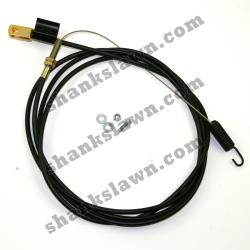Clutches, throttles, adjusters and kill switches are all linked to the hand controls using cables, which makes maintaining these easy-to-overlook parts critical to keeping your Billy Goat equipment working correctly. Whether you have a Grazor with a single clutch lever or a Hydro Aerator with multiple levers for height and speed control, the same methods can be applied to clean and lubricate any cable found on your equipment.
How Cables Work
The cable connects the controls on the handle of your equipment to components on the base including the engine throttle, clutches and height adjusters. At least part of this cable is covered by a casing. No matter how the casing bends, it has a fixed length, letting the cable move around while maintaining the distance needed to actuate the device at the other end. Usually, only a section of the cable is covered in a casing to compensate for movement of the handle and base, while cable near fixed areas at the ends of the handle and the device being controlled are left exposed. Metal ferrules at the ends of the cable support the soft casing and help keep it in the mounting slots on the equipment.
Keeping Your Cables from Freezing
While it is possible to stretch a cable out over time, most failures are the result of rust or physical damage that can keep the cable from moving.
Rust is caused by water collecting on the cable. Along with direct exposure, dirt can draw in moisture from the air and keep it in contact with the cable. To keep this from happening, wipe the exposed areas of the cable clean after use.
Most physical damage is the result of crimping. Make sure all the cables are clear before folding the handle for storage or transport.
Lubricating the Cable
Billy Goat recommends lubricating cables after every 25 hours of use. There are two ways to apply lubricant:
Expose as much cable as possible on each end and soak these ends in lubricant. Move the cable back and forth to spread it across the cable.
Detach the top of the cable from the equipment. Clamp on a cable lubrication tool, or make one using a short piece of hose and a hose clamp. If you choose the latter method, make sure the clamp isn’t so tight that it damages the ferrule or casing. Fill the tool or hose with lubricant. After a couple of minutes, the lubricant should drip out of the other end of the casing. Remove the tool, reinstall the cable, and move the lever back and forth to ensure an even coating across the exposed parts of the cable.
Picking a Lubricant
Billy Goat doesn’t specify a specific lubricant for their cables, leaving plenty of options. Some of these will work fine, while others can cause problems down the line.
Penetrating oils like WD-40, PB B’laster and Liquid Wrench are designed to remove grease and water from components, not lubricate them. While they may seem to work at first, they won’t stick to the cable, leaving it dry and exposed to water damage.
Some oils have detergents in them which can gum up over time, holding dirt onto the cable and making it stick to the casing. This includes modern multi-weight motor oils and household multi-purpose oils like 3-in-1. While they may make the cable move smoother at first, it’s common for the detergent to cause the cable to stick or freeze while the equipment is in storage.
What should you use, then? Any of these products will work:
– Cable or cable and chain lubricant for motorcycles
– Light oil lubricant
– Silicone lubricant
– Air tool oil
– Non-detergent SAE 30
– Electric motor oil, which may be SAE 30 or a paraffin base oil
– Graphite lubricant
When in doubt, check the label: it should say “non-gumming.”
While there is some debate over whether graphite is the best choice since it doesn’t let dirt adhere to cables like oil-based lubricants, this should be a non-issue as long as you clean the cables.
Getting a Replacement Cable
While you may be able to free a stuck or damaged cable, the next time it gets stuck, it could keep you from shutting off a clutch or shifting out of gear, which presents a major safety hazard. Getting a replacement is simple: just visit www.billygoatparts.com. We carry everything you need to keep your Billy Goat equipment running, including cables, and we can ship your order to any location in the U.S. and Canada.

